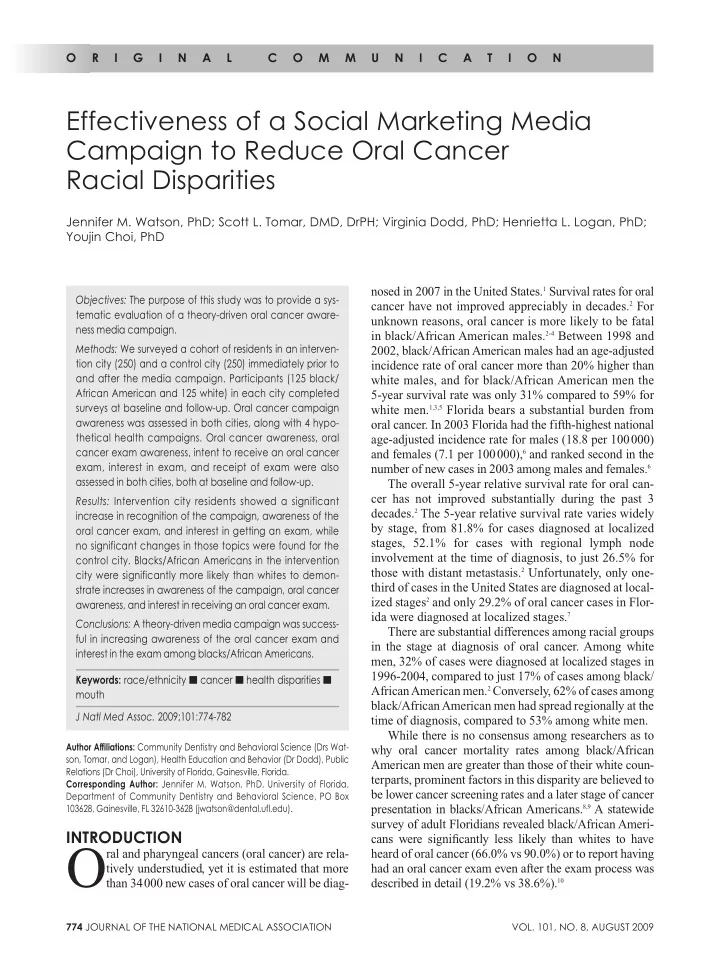

o r i g i n a l c o m m u n i c a t i o n Effectiveness of a Social Marketing Media Campaign to Reduce Oral Cancer Racial Disparities Jennifer M. Watson, PhD; Scott L. Tomar, DMD, DrPH; Virginia Dodd, PhD; Henrietta L. Logan, PhD; Youjin Choi, PhD nosed in 2007 in the United States. 1 Survival rates for oral Objectives: The purpose of this study was to provide a sys- cancer have not improved appreciably in decades. 2 For tematic evaluation of a theory-driven oral cancer aware- unknown reasons, oral cancer is more likely to be fatal ness media campaign. in black/African American males. 2-4 Between 1998 and Methods: We surveyed a cohort of residents in an interven- 2002, black/African American males had an age-adjusted tion city (250) and a control city (250) immediately prior to incidence rate of oral cancer more than 20% higher than and after the media campaign. Participants (125 black/ white males, and for black/African American men the African American and 125 white) in each city completed 5-year survival rate was only 31% compared to 59% for surveys at baseline and follow-up. Oral cancer campaign white men. 1,3,5 Florida bears a substantial burden from awareness was assessed in both cities, along with 4 hypo- oral cancer. In 2003 Florida had the fifth-highest national thetical health campaigns. Oral cancer awareness, oral age-adjusted incidence rate for males (18.8 per 100 000) cancer exam awareness, intent to receive an oral cancer and females (7.1 per 100 000), 6 and ranked second in the exam, interest in exam, and receipt of exam were also number of new cases in 2003 among males and females. 6 assessed in both cities, both at baseline and follow-up. The overall 5-year relative survival rate for oral can- Results: Intervention city residents showed a significant cer has not improved substantially during the past 3 increase in recognition of the campaign, awareness of the decades. 2 The 5-year relative survival rate varies widely oral cancer exam, and interest in getting an exam, while by stage, from 81.8% for cases diagnosed at localized no significant changes in those topics were found for the stages, 52.1% for cases with regional lymph node control city. Blacks/African Americans in the intervention involvement at the time of diagnosis, to just 26.5% for city were significantly more likely than whites to demon- those with distant metastasis. 2 Unfortunately, only one- strate increases in awareness of the campaign, oral cancer third of cases in the United States are diagnosed at local- awareness, and interest in receiving an oral cancer exam. ized stages 2 and only 29.2% of oral cancer cases in Flor- ida were diagnosed at localized stages. 7 Conclusions: A theory-driven media campaign was success- There are substantial differences among racial groups ful in increasing awareness of the oral cancer exam and in the stage at diagnosis of oral cancer. Among white interest in the exam among blacks/African Americans. men, 32% of cases were diagnosed at localized stages in 1996-2004, compared to just 17% of cases among black/ Keywords: race/ethnicity n cancer n health disparities n African American men. 2 Conversely, 62% of cases among mouth black/African American men had spread regionally at the J Natl Med Assoc. 2009;101:774-782 time of diagnosis, compared to 53% among white men. While there is no consensus among researchers as to author affiliations: Community Dentistry and Behavioral Science (Drs Wat- why oral cancer mortality rates among black/African son, Tomar, and Logan), Health Education and Behavior (Dr Dodd), Public American men are greater than those of their white coun- Relations (Dr Choi), University of Florida, Gainesville, Florida. terparts, prominent factors in this disparity are believed to corresponding author: Jennifer M. Watson, PhD, University of Florida, Department of Community Dentistry and Behavioral Science, PO Box be lower cancer screening rates and a later stage of cancer 103628, Gainesville, FL 32610-3628 (jwatson@dental.ufl.edu). presentation in blacks/African Americans. 8,9 A statewide survey of adult Floridians revealed black/African Ameri- introduction cans were significantly less likely than whites to have O ral and pharyngeal cancers (oral cancer) are rela- heard of oral cancer (66.0% vs 90.0%) or to report having tively understudied, yet it is estimated that more had an oral cancer exam even after the exam process was than 34 000 new cases of oral cancer will be diag- described in detail (19.2% vs 38.6%). 10 774 JOURNAL OF THE NATIONAL MEDICAL ASSOCIATION VOL. 101, NO. 8, AUGUST 2009
Recommend
More recommend